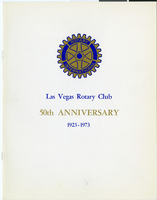Search the Special Collections and Archives Portal
Search Results

Transcript of interview with James Bonnell by Gerald L. Conner, February 22, 1977
Date
Archival Collection
Description
On February 22, 1977, James Bonnell interviewed Gerald L. Connor (born 1930 in Boston, Massachusetts) about his experiences in Nevada and his work in education. Connor first talks about his move to Nevada while he was a member of the United States Air Force. He then discusses his education, including that at the University of Nevada, Las Vegas, and also describes his church membership. Connor later talks about changes in the schools and school district, the growth of gambling and properties located in Downtown Las Vegas and the Las Vegas Strip, and the early atomic tests at the Nevada Test Site. He also describes in detail his political activity and involvement with the Democratic Party, including his work with candidates for the offices of Nevada Governor and United States Senator. Towards the end of the interview, Connor talks about events such as Helldorado, the growth of the city over time, and his thoughts on the future of Las Vegas.
Text
Ralph Roske Photographs
Identifier
Abstract
The Ralph Roske Photographs (approximately 1917-1989) depict life in rural Southern Nevada and newspaper clippings from the Goodsprings Gazette. The collection consists of thirty-five images dated from 1917 to 1989. The images consist of unidentified Nevadans, Las Vegas landmarks, and members of the McAllister family in Carraca, Nevada.
Archival Collection
J. T. McWilliams Photograph Collection
Identifier
Abstract
The J. T. McWilliams Photograph Collection contains photographs and postcards from Nevada and Southern California from approximately 1900 to 1970. The materials include postcards depicting Las Vegas, Nevada casinos such as El Rancho Vegas and the Golden Nugget Gambling Hall. The materials also include postcards depicting towns and scenes in Nevada such as Carson City, Rhyolite, Red Rock Canyon, and covered wagons traveling to Las Vegas. Lastly, the materials contain several photographs of the McWilliams family, possibly while they were living in what is now Las Vegas, Nevada.
Archival Collection

Las Vegas Rotary Club 50th Anniversary Program, 1973
Date
Archival Collection
Description
Text
American Red Cross Southern Nevada Chapter Records
Identifier
Abstract
The American Red Cross Southern Nevada Chapter Records (1917-2015) include business records, legal and property documents, scrapbooks, photographs, awards and event programs. Also included is documentation of training events in Southern Nevada and disaster relief efforts throughout the country.
Archival Collection
J. T. McWilliams Family Papers
Identifier
Abstract
The collection consists of letters, greeting cards, survey maps, newspaper clippings, legal papers, photographs, collected recipes, land sales and expense journals, and survey reference books. The material was created or collected by pioneering Nevada surveyor, engineer, and real estate entrepreneur J. T. (John Thomas) McWilliams and his wife, Iona, between 1900 and 1968.
Archival Collection
Tomiyasu Family Photograph Collection
Identifier
Abstract
The Tomiyasu Family Photograph Collection (approximately 1908 to 1991) consists of black-and-white photographic prints of the Tomiyasu family and their farming business in southern Nevada.
Archival Collection

Transcript of Interview with Merna Dennison by Ken Pyatt, March 1, 1980
Date
Archival Collection
Description
Text

Transcript of interview with Laura & Don Garvin by Michael Martocci, March 3, 1979
Date
Archival Collection
Description
On March 3, 1979, Michael Martocci interviewed Laura (born in California) and Don Garvin (born in Goldfield, Nevada) about their lives in Las Vegas, Nevada. The two provide details on their family background, the first sources of water in Las Vegas, and the early city limits. They also describe their early occupations, religion, gambling, the Mormon Fort, and the effects of the Great Depression. The interview concludes with a brief discussion on the development of the Las Vegas Strip and recreational activities.
Text

Transcript of interview with Hal G. Curtis by Bill Teepe, February 24, 1977
Date
Archival Collection
Description
On February 24, 1977, Bill Teepe interviewed Hal G. Curtis (born 1926 in Galt City, California) about his life in Southern Nevada. Curtis talks first about his work on the Union Pacific Railroad before discussing changes and development in Las Vegas, including development on the Strip and Downtown areas. He also talks about Block 16, the El Rancho Vegas fire, social clubs, and religion.
Text
